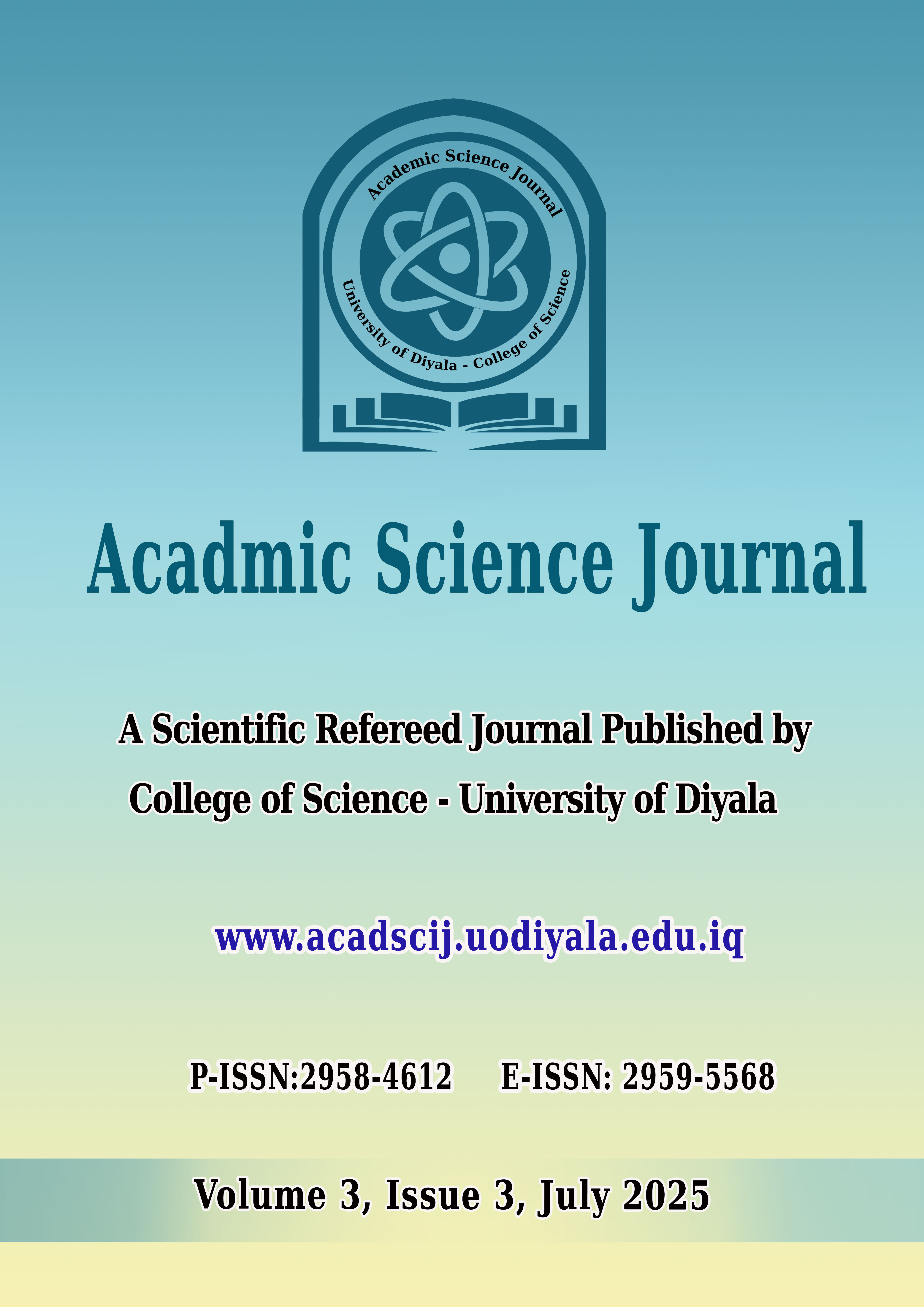The Production of Pyocins of Pseudomonas aeruginosa: A Structure and Methodology Review
Pyocins Production: A review Study
DOI:
https://doi.org/10.24237/ASJ.03.03.881CKeywords:
Pseudomonas aerugionsa bacteriocin, Pyocin, structure, induction, production, extractionAbstract
The main objective of this review is to clarify the definition, types and structures of pyocins. It
also highlights the various methods and their procedures that have been employed to screen,
extract, isolate and purify pyocins from Pseudomonas aeruginosa. Furthermore, this study
provides an analysis of the advantages and disadvantages associated with each approach. This
may aid future research in combating antibiotic resistance that has become increasingly
prevalent in recent years creating a burden on both the medical and financial fronts. In recent
years, the resistance to antibiotics has increased rapidly due to the misuse and the presence of
inhibitory and sub-inhibitory concentrations of antibiotics in various terrestrial and aquatic
environments. The misuse of these antibiotics has led to the emergence and spread of antibiotic
resistant microbes, posing challenges in treating common infections. The understanding of
these findings is crucial for devising strategies to explore alternatives such as pyocins to replace
conventional antibiotics capable of efficiently combating bacterial illnesses. The study
concluded that some techniques may not be very effective at differentiating between types of
pyocins though they are cheap which makes them beneficial for screening. On the other hand
other techniques accurately identify the pyocins, nevertheless, they are costly, complicated, and
need specific tools though some are more expensive than others. Some techniques lack
specificity, and left out centrifuge specifics that are essential to maintaining consistency
between experiments. The initial ammonium sulphate saturation has not been mentioned and a
range with ammonium sulphate precipitation with the highest yield should be measured.
Numerous strains of indicators have been employed, indicating the necessity for more extensive
research to identify trustworthy indicators for consistent outcomes.
Downloads
References
References
CDC, ‘How do germs become resistant?’, Centers for Disease Control and Prevention, 24-Oct-2022. [Online]. Available: https://www.cdc.gov/drugresistance/about/how-resistance-happens.html. [Accessed: 18-Apr-2024].
M. A. Salam et al., ‘Antimicrobial resistance: A growing serious threat for global public health’, Healthcare (Basel), vol. 11, no. 13, p. 1946, Jul. 2023.
J. Oneill, ‘Antimicrobial resistance: Tackling a crisis for the health and wealth of nations (The Review on Antimicrobial Resistance)’, United Kingdom) Rev. Antimicrob. Resist, 2014.
M. P. Mokoena, ‘Lactic acid bacteria and their bacteriocins: Classification, biosynthesis and applications against uropathogens: A mini-review’, Molecules, vol. 22, no. 8, p. 1255, Jul. 2017.
C. K. Anumudu, O. Omoregbe, A. Hart, T. Miri, U. A. Eze, and H. Onyeaka, ‘Applications of bacteriocins of lactic acid bacteria in biotechnology and food preservation: A bibliometric review’, Open Microbiol. J., vol. 16, no. 1, Aug. 2022.
A. Ben Lagha, B. Haas, M. Gottschalk, and D. Grenier, ‘Antimicrobial potential of bacteriocins in poultry and swine production’, Vet. Res., vol. 48, no. 1, p. 22, Apr. 2017.
L. García-Bayona, M. S. Guo, and M. T. Laub, ‘Contact-dependent killing by Caulobacter crescentus via cell surface-associated, glycine zipper proteins’, Elife, vol. 6, Mar. 2017.
D. B. Diep, M. Skaugen, Z. Salehian, H. Holo, and I. F. Nes, ‘Common mechanisms of target cell recognition and immunity for class II bacteriocins’, Proc. Natl. Acad. Sci. U. S. A., vol. 104, no. 7, pp. 2384–2389, Feb. 2007.
F. W. J. Collins et al., ‘Bacteriocin Gene-Trait matching across the complete Lactobacillus Pan-genome’, Sci. Rep., vol. 7, no. 1, p. 3481, Jun. 2017.
A. Simons, K. Alhanout, and R. E. Duval, ‘Bacteriocins, antimicrobial peptides from bacterial origin: Overview of their biology and their impact against multidrug-resistant bacteria’, Microorganisms, vol. 8, no. 5, p. 639, Apr. 2020.
M. G. K. Ghequire and R. De Mot, ‘Ribosomally encoded antibacterial proteins and peptides from Pseudomonas’, FEMS Microbiol. Rev., vol. 38, no. 4, pp. 523–568, Jul. 2014.
K. Kirtonia et al., ‘Bacteriocin: A new strategic antibiofilm agent in food industries’, Biocatal. Agric. Biotechnol., vol. 36, no. 102141, p. 102141, Sep. 2021.
K. I. Wolska, K. Grześ, and A. Kurek, ‘Synergy between novel antimicrobials and conventional antibiotics or bacteriocins’, Pol. J. Microbiol., vol. 61, no. 2, pp. 95–104, 2012.
L. L. Newstead, K. Varjonen, T. Nuttall, and G. K. Paterson, ‘Staphylococcal-produced bacteriocins and antimicrobial peptides: Their potential as alternative treatments for staphylococcus aureus infections’, Antibiotics (Basel), vol. 9, no. 2, p. 40, Jan. 2020.
V. Vadyvaloo, J. W. Hastings, M. J. van der Merwe, and M. Rautenbach, ‘Membranes of class IIa bacteriocin-resistant Listeria monocytogenes cells contain increased levels of desaturated and short-acyl-chain phosphatidylglycerols’, Appl. Environ. Microbiol., vol. 68, no. 11, pp. 5223–5230, Nov. 2002.
M. Opsata, I. F. Nes, and H. Holo, ‘Class IIa bacteriocin resistance in Enterococcus faecalis V583: the mannose PTS operon mediates global transcriptional responses’, BMC Microbiol., vol. 10, p. 224, Aug. 2010.
H. Etayash, S. Azmi, R. Dangeti, and K. Kaur, ‘Peptide Bacteriocins - Structure Activity Relationships’, Curr. Top. Med. Chem., vol. 16, no. 2, pp. 220–241, Sep. 2015.
P. P. Kandel, D. A. Baltrus, and K. L. Hockett, ‘Pseudomonas can survive tailocin killing via persistence-like and heterogenous resistance mechanisms’, J. Bacteriol., vol. 202, no. 13, Jun. 2020.
M. Kjos, L. Snipen, Z. Salehian, I. F. Nes, and D. B. Diep, ‘The abi proteins and their involvement in bacteriocin self-immunity’, J. Bacteriol., vol. 192, no. 8, pp. 2068–2076, Apr. 2010.
Y. Long et al., ‘Fis contributes to resistance of Pseudomonas aeruginosa to ciprofloxacin by regulating pyocin synthesis’, J. Bacteriol., vol. 202, no. 11, May 2020.
A. Alqahtani, J. Kopel, and A. Hamood, ‘The in vivo and in vitro assessment of pyocins in treating Pseudomonas aeruginosa infections’, Antibiotics (Basel), vol. 11, no. 10, p. 1366, Oct. 2022.
L. Blasco et al., ‘Study of 32 new phage tail-like bacteriocins (pyocins) from a clinical collection of Pseudomonas aeruginosa and of their potential use as typing markers and antimicrobial agents’, Sci. Rep., vol. 13, no. 1, p. 117, Jan. 2023.
L. Laureti, I. Matic, and A. Gutierrez, ‘Bacterial responses and genome instability induced by subinhibitory concentrations of antibiotics’, Antibiotics (Basel), vol. 2, no. 1, pp. 100–114, Mar. 2013.
A. A. Mohamed, A. M. Elshawadfy, G. Amin, and A. Askora, ‘Characterization of R-pyocin activity against Gram-positive pathogens for the first time with special focus on Staphylococcus aureus’, J. Appl. Microbiol., vol. 131, no. 6, pp. 2780–2792, Dec. 2021.
S. Ito, M. Kageyama, and F. Egami, ‘Isolation and characterization of pyocins from several strains of Pseudomonas aeruginosa’, J. Gen. Appl. Microbiol., vol. 16, no. 3, pp. 205–214, 1970.
B. A. Iwalokun, K. A. Akinsinde, O. Lanlenhin, and C. C. Onubogu, ‘Bacteriocinogenicity and production of pyocins from Pseudomonas species isolated in Lagos, Nigeria’, Nigeria. Nigeria African Journal of Biotechnology, vol. 5, no. 11, pp. 1072–1077, 2006.
S. A. Morse, P. Vaughan, D. Johnson, and B. H. Iglewski, ‘Inhibition of Neisseria gonorrhoeae by a bacteriocin from Pseudomonas aeruginosa’, Antimicrob. Agents Chemother., vol. 10, no. 2, pp. 354–362, Aug. 1976.
W. Chang, D. A. Small, F. Toghrol, and W. E. Bentley, ‘Microarray analysis of Pseudomonas aeruginosa reveals induction of pyocin genes in response to hydrogen peroxide’, BMC Genomics, vol. 6, no. 1, p. 115, Sep. 2005.
Z. A. Mohsin and W. S. Ali, ‘Antagonistic Activity of Bacteriocin-producing Lactobacillus Against Candida spp’, Iraqi J. Sci., pp. 2153–2162, Jul. 2021.
E. Ünal Turhan, Z. Ergi̇nkaya, A. Bayram Türemi̇ş, and M. Terkuran, ‘Antibacterial effect of bacteriocinogenic enterococci from different sources on Listeria monocytogenes’, Tarım bilim. derg., Mar. 2020.
J. A. Fyfe, G. Harris, and J. R. Govan, ‘Revised pyocin typing method for Pseudomonas aeruginosa’, J. Clin. Microbiol., vol. 20, no. 1, pp. 47–50, Jul. 1984.
G. Zheng and M. F. Slavik, ‘Detection and demonstration of inhibitory activities of bacteriocins by isoelectric focusing’, J. Rapid Methods Automat. Micro., vol. 6, no. 3, pp. 219–224, Oct. 1998.
R. Harasawa, K. Suzuki, and T. Mitsuoka, ‘Streptococcus faecium-derived antibacterial substance antagonistic to Bifidobacteria’, Antimicrob. Agents Chemother., vol. 18, no. 1, pp. 58–62, Jul. 1980.
D. A. Kékessy and J. D. Piguet, ‘New method for detecting bacteriocin production’, Appl. Microbiol., vol. 20, no. 2, pp. 282–283, Aug. 1970.
H. Tomita, S. Fujimoto, K. Tanimoto, and Y. Ike, ‘Cloning and genetic organization of the bacteriocin 31 determinant encoded on the Enterococcus faecalis pheromone-responsive conjugative plasmid pYI17’, J. Bacteriol., vol. 178, no. 12, pp. 3585–3593, Jun. 1996.
A. de Jong, S. A. F. T. van Hijum, J. J. E. Bijlsma, J. Kok, and O. P. Kuipers, ‘BAGEL: a web-based bacteriocin genome mining tool’, Nucleic Acids Res., vol. 34, no. Web Server issue, pp. W273-9, Jul. 2006.
L. F. Jones, B. V. Pinto, E. T. Thomas, and J. J. Farmer 3rd, ‘Simplified method for producing pyocins from Pseudomonas aeruginosa’, Appl. Microbiol., vol. 26, no. 1, pp. 120–121, Jul. 1973.
H. A. Ibrahim and N. H. Zaki, ‘The biological activity of some extracted proteins from Bacillus spp. Isolated from soil against pathogenic bacteria’, Al-Mustansiriyah J. Sci., vol. 30, no. 4, pp. 29–38, Jan. 2020.
D. S. Bedan, ‘Extraction, precipitation and characterization of urease from Vicia faba L. Al-Mustansiriyah’, J Sci, vol. 31, no. 1, pp. 9–14, 2020.
S. N. Muslim, ‘Production and partial purification of tannase from Serratia marcescens isolated from different sources’, Al-Mustansiriyah J. Sci., vol. 28, no. 3, pp. 109–121, Jul. 2018.
S. A. Naz and S. A. Rasool, ‘Isolation, production and characterization of bacteriocins produced by strains from indigenous environments’, Pakistan Journal of Botany, vol. 45, no. 1, pp. 261–267, 2013.
L. C. McCaughey, N. D. Ritchie, G. R. Douce, T. J. Evans, and D. Walker, ‘Efficacy of species-specific protein antibiotics in a murine model of acute Pseudomonas aeruginosa lung infection’, Sci. Rep., vol. 6, p. 30201, Jul. 2016.
Š. Paškevičius, U. Starkevič, A. Misiūnas, A. Vitkauskienė, Y. Gleba, and A. Ražanskienė, ‘Plant-expressed pyocins for control of Pseudomonas aeruginosa’, PLoS One, vol. 12, no. 10, p. e0185782, Oct. 2017.
D. K. Karig, S. Bessling, P. Thielen, S. Zhang, and J. Wolfe, ‘Preservation of protein expression systems at elevated temperatures for portable therapeutic production’, J. R. Soc. Interface, vol. 14, no. 129, p. 20161039, Apr. 2017.
J. J. Farmer III and L. G. Herman, ‘Epidemiological fingerprinting of Pseudomonas aeruginosa by the production of and sensitivity to pyocin and Bacteriophage1’, Appl. Microbiol., vol. 18, no. 5, pp. 760–765, 1969.
A. W. Negash and B. A. Tsehai, ‘Current applications of bacteriocin’, Int. J. Microbiol., vol. 2020, p. 4374891, Nov. 2020.
Downloads
Published
Issue
Section
License
Copyright (c) 2025 CC BY 4.0

This work is licensed under a Creative Commons Attribution 4.0 International License.












